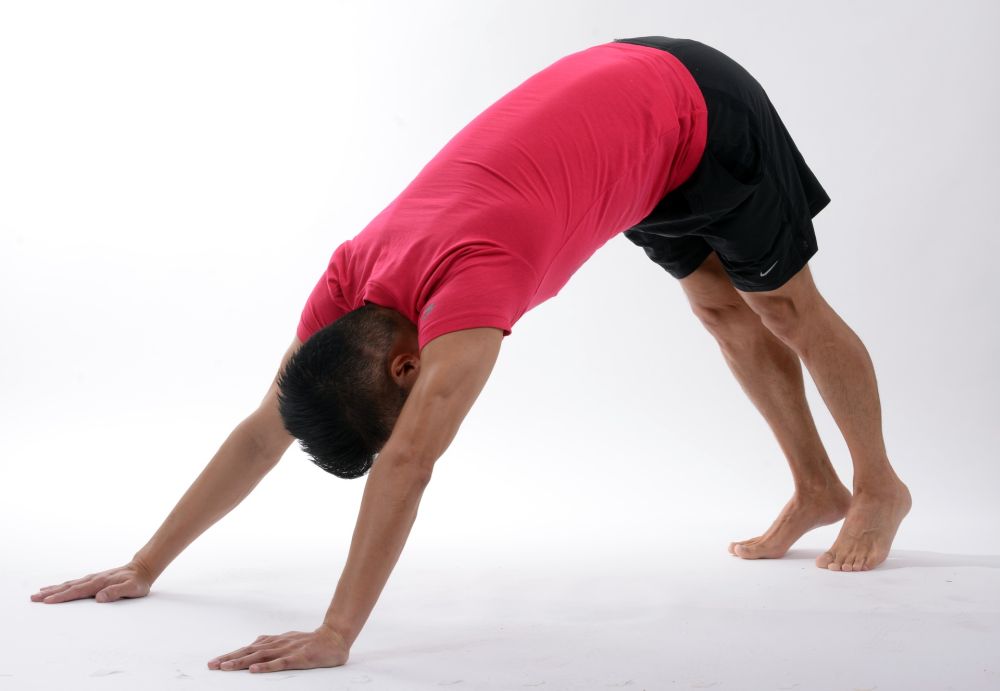
Downward Facing Dog, or Adho Mukha Svanasana is one of the most widely known yoga. It is part of a popular yoga sequence, Sun Salutation. Many yoga teachers advocate this pose as one of the most important to learn.
This posture has numerous benefits for your health and well-being. But it is not a beginner pose. Too many yoga classes begin by teaching this asana to complete yoga beginners.
Downward Facing Dog is a total body posture. And it is an inversion, among some of the most advanced yoga poses. It requires high amounts of strength, flexibility and stamina to perform correctly.
Panaprium is independent and reader supported. If you buy something through our link, we may earn a commission. If you can, please support us on a monthly basis. It takes less than a minute to set up, and you will be making a big impact every single month. Thank you!
The Benefits of Downward Facing Dog or Adho Mukha Svanasana.

Regular practice provides amazing benefits for your body, but also your mind and spirit. If you do Downward Facing Dog often enough, you will definitely see positive changes in yourself.
Adho Mukha Svanasana is one of the most powerful yoga posture for health and wellness when done right. Here are some of the many benefits of this amazing yoga pose:
- Stretches the shoulders and the chest.
- Builds upper body strength.
- Strengthens the legs and thighs.
- Lengthens the hamstrings, calves and spine.
- Rejuvenates the body.
- Boosts the immune system.
- Increases digestion and detoxification.
- Improves circulation and heart health.
- Reduces fatigue and gives energy.
- Calms the mind and and helps relax.
- Relieves stress and anxiety.
- Balances hormones.
- Stabilizes blood pressure.
- Relieves headaches and migraines.
- Eases back pain.
- Strengthens the wrists.
- Improves focus and concentration.
Adho Mukha Svanasana Is Not For Beginners.

Many new students want to do too much too fast. It is one of the most common mistakes beginners make when starting out with yoga.
Practicing Downward Facing Dog, it is easy to overstretch and strain your muscles if you are not prepared. Inversions are not beginner poses.
There are many beginner yoga poses to master before Adho Mukha Svanasana. They help you build the necessary strength, flexibility and focus necessary.
New yogis need at least a few months of regular yoga practice before jumping into inversions.
With good preparation, you will progress faster and ease into most challenging postures. You will avoid injuries and make your practice even more enjoyable.
Join the private Panaprium Support Group for personalized guidance and support on your yoga journey. A supportive community of experienced yogis will answer your questions daily.
How To Do Downward Facing Dog or Adho Mukha Svanasana.
There are many different ways to get into Downward Facing Dog. It depends on the yoga sequence your are doing and the type of yoga.
I highly recommend you learn the pose separately and gently the first time. Practice it often before transitioning into it with fast movements.
- Start on all four.
- Place your hands under your shoulders.
- Place your knees under your hips.
- Stretch your elbows.
- Relax your back.
- Spread your fingers wide.
- Push with your toes and hands.
- Lift up your hips.
- Straighten your legs.
- Keep your feet hip width apart.
- Press the floor away with your hands.
- Lengthen your spine.
- Keep your back straight.
- Draw your chest towards your thighs.
- Align ears and upper arms together.
- Press your upper arms towards each other.
- Engage your quadriceps.
- Sink your heels into floor.
- Stretch the back of your legs.
- Let your head and neck hang freely.
- Breathe deeply.
Summing up:
Adho Mukha Svanasana or Downward Facing Dog is a very powerful yoga pose. This posture is widely popular for good reasons. It has numerous benefits for your body, mind and spirit.
But it is not a beginner friendly pose. It is a challenging inversion that requires flexibility, strength, endurance and focus. Practice beginner poses at home to ease into it.
Inspirations:
Was this article helpful to you? Please tell us what you liked or didn't like in the comments below.
About the Author: Alex Assoune
What We're Up Against
Multinational corporations overproducing cheap products in the poorest countries.
Huge factories with sweatshop-like conditions underpaying workers.
Media conglomerates promoting unethical, unsustainable products.
Bad actors encouraging overconsumption through oblivious behavior.
- - - -
Thankfully, we've got our supporters, including you.
Panaprium is funded by readers like you who want to join us in our mission to make the world entirely sustainable.
If you can, please support us on a monthly basis. It takes less than a minute to set up, and you will be making a big impact every single month. Thank you.































0 comments